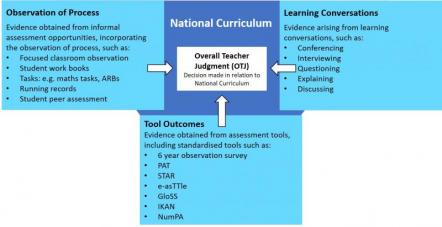You are here:
- Home »
- Using evidence for learning »
- Gathering evidence »
- Assessment methods
Using a range of assessment methods
No single source of assessment information can accurately summarise a student’s achievement or progress. A range of approaches is necessary in order to compile a comprehensive picture of the areas of progress, areas requiring attention, and what a student’s unique progress looks like.
Assessment is central to teaching and learning
The nature and purposes of assessment are described on pages 39–41 of the New Zealand Curriculum. The primary purpose of assessment is to improve students’ learning, as both student and teacher respond to the information it provides.
Information is needed about what knowledge, understanding or skills students need. By finding out what students currently know, understand and can do, any gap between the two can be made apparent. Assessment is the process of gaining information about the gap and learning is about attempts to reduce the gap.
Using a range of approaches to assessment allows the student to participate throughout the assessment process, building their assessment capability.
The diagram on this page provides an overview of the types of information which can be used to make an Overall Teacher Judgment in relation to curriculum expectations. Any one of the three boxes provides an approach to gathering evidence of learning. The use of a range of evidence accumulated over time builds dependability in progress and achievement decisions. An overall teacher judgment can be made when the teacher reviews all of the evidence in relation to the curriculum.
Most assessment is informal and "of the moment"
Teachers can get a very good perspective on their students’ progress if they collect evidence from a range of sources. Teachers’ own assessments (including teacher-made tests, anecdotal notes, conversations with students, portfolios of work, and quizzes), together with the results of more formal general assessments and students’ own perspective of the learning and achievement, can provide a reliable basis for identifying progress.
There is also a need for more formal assessment
Formal assessment ensures consistency in the interpretation of both progress and achievement by students and teachers. It also helps to ensure that other stakeholders in education (including syndicates or departments, senior school management, boards of trustees, parents and family, and the Ministry of Education) get the types of information that they need in order to be able to support teaching and learning. These assessments use formal tools, and are often conducted across classes, cohorts or whole school.
The following principles (from The New Zealand Curriculum 2007, p.40) should be kept in mind when choosing assessment methods and tools.
Effective assessment:
- Benefits students – It clarifies for them what they know and can do and what they still need to learn. When students see that they are making progress, their motivation is sustained and their confidence increases.
- Involves students – They discuss, clarify, and reflect on their goals, strategies, and progress with their teachers, their parents, and one another. This develops students’ capacity for self- and peer assessment, which lead in turn to increased self-direction.
- Supports teaching and learning goals – Students understand the desired outcomes and the criteria for success. Important outcomes are emphasised, and the teacher gives feedback that helps the students to reach them.
- Is planned and communicated – Outcomes, teaching strategies, and assessment criteria are carefully matched. Students know in advance how and why they are to be assessed. The teacher’s programme planning is flexible so that they can make changes in response to new information, opportunities, or insights.
- Is suited to the purpose – Evidence is obtained through a range of informal and formal assessment approaches. These approaches are chosen to suit the nature of the learning being assessed, the varied characteristics and experiences of the students, and the purpose for which the information is to be used.
- Is valid and fair – Teachers obtain and interpret information from a range of sources and then base decisions on this evidence, using their professional judgment. Conclusions are most likely to be valid when the evidence for them comes from more than one assessment.
Related concepts

Standards-based assessment
Standards-based assessment relies on teachers making qualitative judgments about student’s learning.


